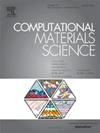探索Nb/Pd掺杂对ZrCo(110)表面抗氧中毒作用的第一性原理研究
IF 3.3
3区 材料科学
Q2 MATERIALS SCIENCE, MULTIDISCIPLINARY
引用次数: 0
摘要
在实际应用中,锆钴(ZrCo)合金通常会受到各种杂质气体的毒害,导致储氢性能的严重损失。本研究基于密度泛函理论,致力于揭示Nb/Pd掺杂对zrco基体系抗氧中毒性能的影响。利用吸附能评价氧分子在ZrCo(110)表面的吸附性能,表明Nb/Pd掺杂导致吸附能力下降。研究还发现,掺杂剂不利于氧原子在空心位点的吸附。晶体轨道汉密尔顿居群分析进一步证实了掺杂削弱了氧原子与相邻原子之间的化学键。此外,还采用爬升图像微推弹性带法测定了氧原子的扩散势垒。结果表明,Pd掺杂对合金的表面迁移和亚表面渗透具有较高的扩散势垒,从而增强了合金的抗氧中毒能力。相比之下,Nb掺杂表现出相反的扩散趋势。这项工作有望对元素掺杂后ZrCo(110)表面氧中毒机理提供有价值的见解,有利于实际应用储氢材料的开发。本文章由计算机程序翻译,如有差异,请以英文原文为准。

Exploring the role of Nb/Pd doping on the resistance to oxygen poisoning on the ZrCo(110) surface: A first-principles study
In practice, zirconium–cobalt (ZrCo) alloys are usually poisoned by various impurity gases, resulting in severe loss of hydrogen storage performance. This study is dedicated to revealing the influence of Nb/Pd doping on oxygen poisoning resistance of ZrCo-based system on the basis of the density functional theory. Adsorption energies are employed to evaluate the adsorption performance of oxygen molecule on the ZrCo(110) surface, demonstrating that the Nb/Pd doping leads to a degraded adsorption capability. It was also discovered that the dopants are unfavorable for the oxygen atom adsorption at the hollow sites. The crystal orbital Hamilton population analysis further confirms that the doping weakens the chemical bonding between oxygen atom and adjacent atoms. In addition, the diffusion barrier for oxygen atom is determined by the climbing image nudged elastic band method. The results show that there is a higher diffusion barrier for the Pd doping for the surface migration and subsurface penetration, thereby enhancing the resistance of the alloy to oxygen poisoning. As compared, the Nb doping exhibits an opposite trend for diffusion behavior. This work is expected to offer valuable insights into the mechanism of oxygen poisoning on the ZrCo(110) surface after element doping, beneficial to the development of hydrogen storage materials for practical applications.
求助全文
通过发布文献求助,成功后即可免费获取论文全文。
去求助
来源期刊

Computational Materials Science
工程技术-材料科学:综合
CiteScore
6.50
自引率
6.10%
发文量
665
审稿时长
26 days
期刊介绍:
The goal of Computational Materials Science is to report on results that provide new or unique insights into, or significantly expand our understanding of, the properties of materials or phenomena associated with their design, synthesis, processing, characterization, and utilization. To be relevant to the journal, the results should be applied or applicable to specific material systems that are discussed within the submission.
 求助内容:
求助内容: 应助结果提醒方式:
应助结果提醒方式:


